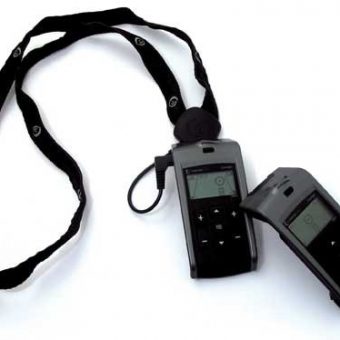Remote microphones and personal listening systems are a proven and effective way to to stay engaged in the conversation. They significantly increase the sound you want to hear over surrounding noise. This is because they capture sound much closer to the source. They also deliver that sound straight to you. Consequently, they overcome the challenges presented by noise, reverb, distance and inner ear damage.
Remote mics for face-to-face communication in noise
Remote mics are ideal for small face-to-face conversations in a noisy place like a restaurant or car. You can ask someone to wear a remote mic on their shirt. My husband and I enjoy much smoother conversations on our daily walks when he wears a remote mic. It sends the sound wirelessly to my hearing aids. I can mute out background noise from the cars going past for even better sound.
Remote mics for distance and reverb
Remote mics also work extremely well to hear someone far away. Again, you can ask someone to wear your remote mic. Alternatively, you can place a remote mic on a podium or table. For instance, when some speaks to an audience and there is no public listening system for people with hearing loss. I put my remote mic on the podium at gatherings like a town meeting. That way, it doesn’t matter how far away I am in the room. In addition, I hear all the people who step up to the podium. The only issue is when they walk around too much. I also put my remote mic on the anbo (podium) in an unfamiliar church. This makes a funeral or wedding a much better experience. I am so happy when I can hear the eulogy or wedding sermon. It’s such an important connection to the people involved.
Proprietary systems
All of the large hearing aid manufacturers offer a remote mic that works with their brand of hearing aid/CI.
Off-the-shelf systems
There are an increasing number of Bluetooth remote mics available online that you can pair to a phone or headphones. There are also complete personal listening systems sold online and by specialty vendors. These feature a receiver other than hearing aids.
Lifestyle considerations
There are different kinds of remote mics, so you should consider your lifestyle. Do you go to noisy restaurants, work meetings, town hall debates, or cocktail parties? You can use just one remote mic with some success in almost any setting. However, certain features and styles work better in certain situations.
Features to look for
- omnidirectional vs. directional –
- omnidirectional mics pick up sound from every direction (360°). Recently I also purchased a table mic with an omnidirectional microphone for business meetings. Omnidirectional mics work well when you want to hear more than one person sitting around a table. Table mics are usually omnidirectional.
- directional mics pick up sound primarily from only one direction. These work well in noisy places where you want to block out a lot of surrounding sound. Lapel worn remote mics are usually directional. Sometimes I ask a presenter to wear it. I also use a handheld mic at parties. It helps when I move around to talk with different people.
- some mics, like the Phonak Select, can switch between omnidirectional and directional.
- adaptive gain vs. fixed gain –
- adaptive gain mics adjust for noise. For example, when riding in a car my husband wears my remote mic. It removes all the road noise in between the times he is talking. These intermittent silences make it less fatiguing for me. I must admit it is also a little jarring when he starts talking again.
- fixed gain mics amplify all sounds equally. I like the even flow of fixed gain mics. It’s a matter of personal preference.
- built-in telecoil – provides greater access to a variety of listening systems and better listening ability. Remote mics with a telecoil built-in enables you to use hearing aids that don’t have a telecoil in situations where you need one. For example, you can use them with public venues that have loop, FM, and IR systems. You won’t have to use earbuds or headphones.
- 3.5 mm headphone jack – allows a wired connection to many audio devices. You can plug it into your computer, tablet, phone, etc. or even the audio jack for an airplane movie.
- Europlug or Direct Audio Input (DAI) – allows an external audio source or audio receiver to connect directly as input. For example, a computer, TV, phone can be connected with a cable. In addition, an FM microphone system connects wirelessly by plugging in a 3-pin FM receiver. This feature enables you to use a different brand of FM microphone system with your brand of hearing aid. For example, you can use the Phonak “Roger” remote mics even if your hearing aids are not Phonak.
Where else do you struggle in noise? I hope you try remote microphones and personal listening systems. I think the additional benefit will surprise you.





